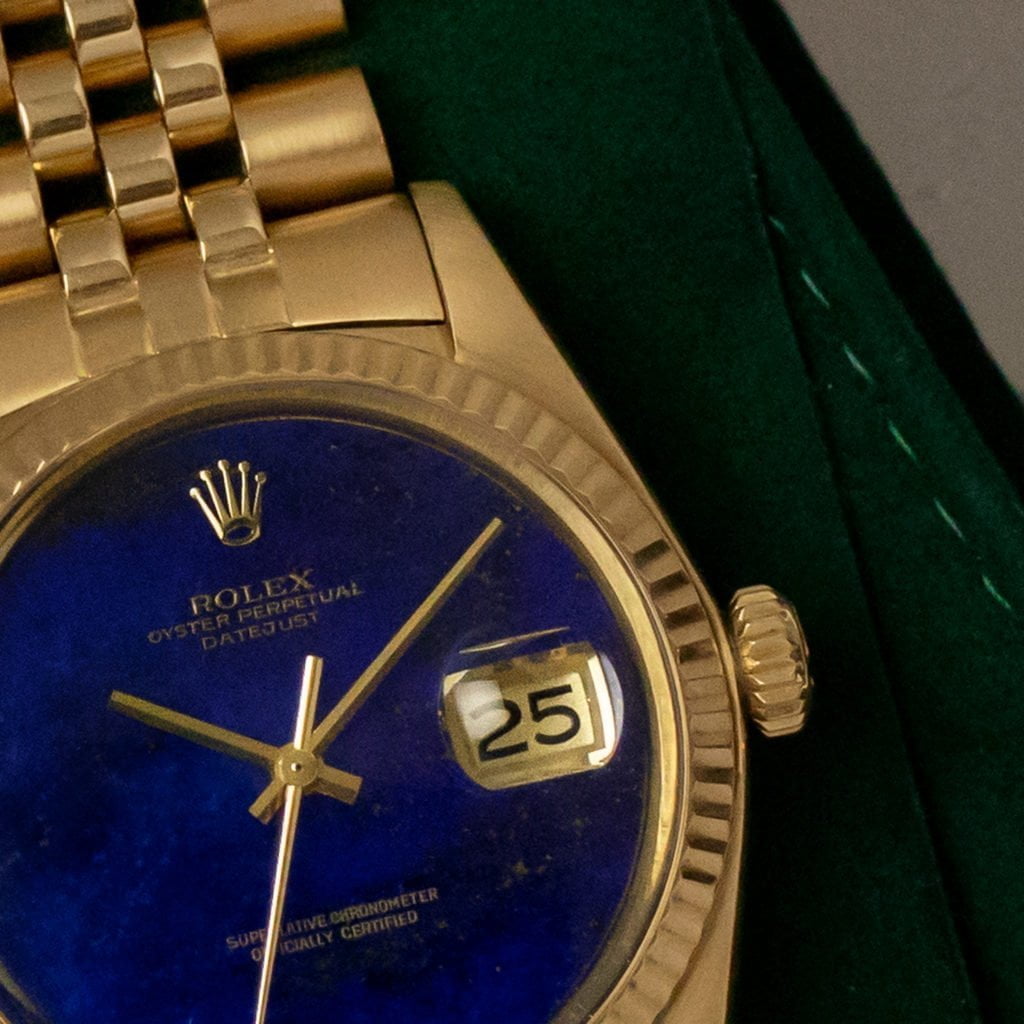Rolex Datejust 1601/8 'Lapis Lazuli'
SoldRolex Datejust 1601/8 'Lapis Lazuli'
- Free worldwide delivery
What color is the sky? Blue, right? It’s always been and always will be. Even though blue is one of the most visible colors around us, it's one of the last color names to develop in most languages. According to linguists, this had to do with the immense difficulty to produce a blue pigment or dye for everyday use. For a long time, the most reliable way to produce blue paint was to ground down lapis lazuli, a semi-precious stone that has been mined for millennia in Afghanistan. The resultant pigment, called ultramarine, produces a vibrant blue color. Due to its beautiful hue, and exorbitant price, Renaissance and Baroque painters used it almost exclusively to depict the robes of the Virgin Mary.Lapis lazuli dials are among the most coveted stone dials produced by Rolex. The vast majority of them appeared in Day-Dates. A few weeks ago we offered an exceedingly rare 18k white gold Datejust with lapis dial, this week we have another one in 18k yellow-gold!Stone dials are beautiful due to the natural variation of the stones used, but they’re also quite fragile. Many of them have developed cracks or rips over the years. Therefore, a flawless dial will increase the value greatly. This lapis dial is in faultless condition and the most desirable variation of lapis lazuli. Lapis lazuli often occurs in nature with deposits of two other minerals: calcite (which shows as white veins in the stone) and pyrite (which look like gold veins). This dial contains no calcite deposits and some evenly spaced golden pyrite flecks. Stone dials typically contain no markers and together with the gold and gold applied Rolex coronet the dial takes on a majestic blue and gold hue.The lapis dial is housed in a thick 18k yellow-gold case with matching fluted bezel. To complete the package, the watch comes on a period-correct 18k yellow-gold Jubilee bracelet.
Introduction
Rolex DatejustIn 1945 Rolex created the flagship Datejust to mark the company’s 40th anniversary. This model was the world’s first self-winding wristwatch with a date indication. With the Datejust, Rolex also introduced the iconic 5-piece jubilee bracelet, first in solid gold and later in bicolor and stainless steel. On the tenth anniversary of the Datejust in 1955, the magnifying ‘cyclops lens’ was introduced on the Datejust.Ref. 16xx (1600, 1601, 1603)The Datejust 16xx series was produced in the 1960s and the 1970s. These affordable and user-friendly Datejusts are the perfect vintage ‘daily beaters’ that can be combined with any outfit and worn on every occasion. The Datejust is usually fitted with a Jubilee bracelet, but the ref. 1600 could also be ordered on an Oyster bracelet. This reference came with a smooth bezel (domed bezel) and was available in either (white, yellow, or rose) gold or in stainless steel. The ref. 1601 came with a fluted bezel in gold and was available with a steel, bicolor, or (white, yellow and rose gold) case and bracelet. The ref. 1603 was only made in steel and featured an engine turned bezel in steel.The dial colors and configurations varied among the 16xx series Datejusts. Characteristic for this era of production is the so-called ‘Pie-Pan’ dial where the dial looks like an upside-down pie-pan (a concentric ring that slopes down from the flat centre).
Specifications
- SKU 5948
- Bezel material
- Bracelet
- Caliber
- Case Dimensions
- Case Material
- Clasp
- Dial
- Glass
- Model
- Movement
-
Reference
1601
- Year






